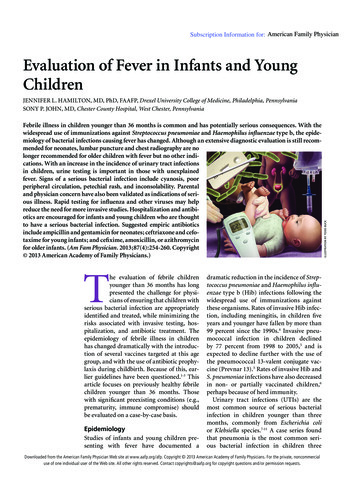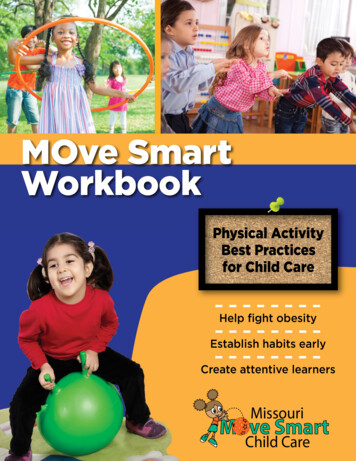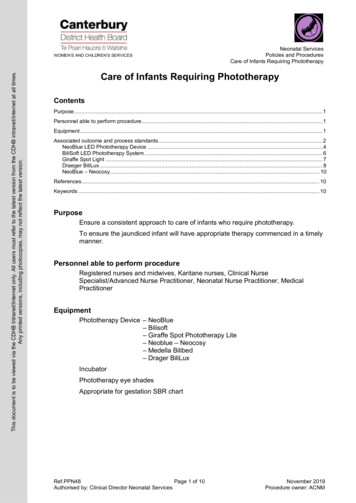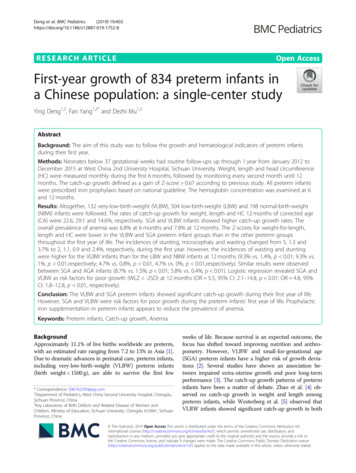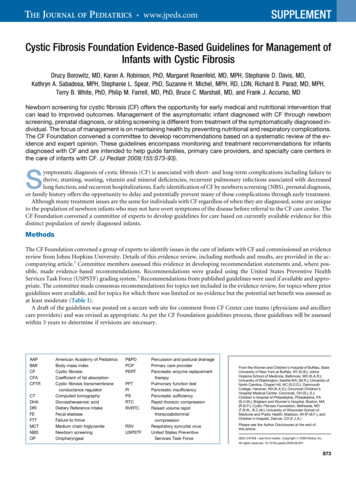
Transcription
Cystic Fibrosis Foundation Evidence-Based Guidelines for Management ofInfants with Cystic FibrosisDrucy Borowitz, MD, Karen A. Robinson, PhD, Margaret Rosenfeld, MD, MPH, Stephanie D. Davis, MD,Kathryn A. Sabadosa, MPH, Stephanie L. Spear, PhD, Suzanne H. Michel, MPH, RD, LDN, Richard B. Parad, MD, MPH,Terry B. White, PhD, Philip M. Farrell, MD, PhD, Bruce C. Marshall, MD, and Frank J. Accurso, MDNewborn screening for cystic fibrosis (CF) offers the opportunity for early medical and nutritional intervention thatcan lead to improved outcomes. Management of the asymptomatic infant diagnosed with CF through newbornscreening, prenatal diagnosis, or sibling screening is different from treatment of the symptomatically diagnosed individual. The focus of management is on maintaining health by preventing nutritional and respiratory complications.The CF Foundation convened a committee to develop recommendations based on a systematic review of the evidence and expert opinion. These guidelines encompass monitoring and treatment recommendations for infantsdiagnosed with CF and are intended to help guide families, primary care providers, and specialty care centers inthe care of infants with CF. (J Pediatr 2009;155:S73-93).Symptomatic diagnosis of cystic fibrosis (CF) is associated with short- and long-term complications including failure tothrive, stunting, wasting, vitamin and mineral deficiencies, recurrent pulmonary infections associated with decreasedlung function, and recurrent hospitalizations. Early identification of CF by newborn screening (NBS), prenatal diagnosis,or family history offers the opportunity to delay and potentially prevent many of these complications through early treatment.Although many treatment issues are the same for individuals with CF regardless of when they are diagnosed, some are uniqueto the population of newborn infants who may not have overt symptoms of the disease before referral to the CF care center. TheCF Foundation convened a committee of experts to develop guidelines for care based on currently available evidence for thisdistinct population of newly diagnosed infants.MethodsThe CF Foundation convened a group of experts to identify issues in the care of infants with CF and commissioned an evidencereview from Johns Hopkins University. Details of this evidence review, including methods and results, are provided in the accompanying article.1 Committee members assessed this evidence in developing recommendation statements and, where possible, made evidence-based recommendations. Recommendations were graded using the United States Preventive HealthServices Task Force (USPSTF) grading system.2 Recommendations from published guidelines were used if available and appropriate. The committee made consensus recommendations for topics not included in the evidence review, for topics where priorguidelines were available, and for topics for which there was limited or no evidence but the potential net benefit was assessed asat least moderate (Table I).A draft of the guidelines was posted on a secure web site for comment from CF Center care teams (physicians and ancillarycare providers) and was revised as appropriate. As per the CF Foundation guidelines process, these guidelines will be assessedwithin 3 years to determine if revisions are ican Academy of PediatricsBody mass indexCystic fibrosisCoefficient of fat absorptionCystic fibrosis transmembraneconductance regulatorComputed tomographyDocosahexaenoic acidDietary Reference IntakeFecal elastaseFailure to thriveMedium chain triglycerideNewborn VUSPSTFPercussion and postural drainagePrimary care providerPancreatic enzyme replacementtherapyPulmonary function testPancreatic insufficiencyPancreatic sufficiencyRapid thoracic compressionRaised volume rapidthoracoabdominalcompressionRespiratory syncytial virusUnited States PreventiveServices Task ForceFrom the Women and Children’s Hospital of Buffalo, StateUniversity of New York at Buffalo, NY (D.B.); JohnsHopkins School of Medicine, Baltimore, MD (K.A.R.);University of Washington, Seattle WA, (M.R.); University ofNorth Carolina, Chapel Hill, NC (S.D.D.); DartmouthCollege, Hanover, NH (K.A.S.); Cincinnati Children’sHospital Medical Center, Cincinnati, OH (S.L.S.);Children’s Hospital of Philadelphia, Philadelphia, PA(S.H.M.); Brigham and Women’s Hospital, Boston, MA(R.B.P.); Cystic Fibrosis Foundation, Bethesda, MD(T.B.W., B.C.M.); University of Wisconsin School ofMedicine and Public Health, Madison, WI (P.M.F.); andChildren’s Hospital, Denver, CO (F.J.A.)Please see the Author Disclosures at the end ofthis article.0022-3476/ - see front matter. Copyright Ó 2009 Mosby Inc.All rights reserved. 10.1016/j.jpeds.2009.09.001S73
THE JOURNAL OF PEDIATRICS www.jpeds.comGuidelines for the Care of Newly Diagnosed Infantswith CFThese guidelines are intended to be used by families, primarycare providers, and care centers. Even though a frameworkhas been developed to standardize optimal care, it is expectedthat care will be individualized to the needs of patients andfamilies. Although the guidelines were developed in responseto the expansion of NBS programs in the United States, theyalso apply to infants diagnosed prenatally or due to a familyhistory. Infants diagnosed with CF due to meconium ileus atbirth or due to a symptomatic presentation should be treatedin a similar manner once their acute medical needs are addressed. Infants diagnosed with CF through NBS are often labeled ‘‘pre-symptomatic,’’ ‘‘asymptomatic,’’ or ‘‘subclinicallyaffected.’’ However, many have clinical manifestations by 1month of age.3 Most infants diagnosed through CF NBSare at risk for some complication of the disease includinghypoelectrolytemia, pancreatic insufficiency (PI), and lungdisease.4Diagnostic and treatment recommendations are listed atthe end of each section and are summarized in Table I.Initial VisitInfants diagnosed with CF through NBS often appear to betotally healthy to the parents, and the diagnosis probablywill be unexpected. Thus, the psychosocial impact of the diagnosis of CF on the family must be carefully addressed at theinitial visit. Infants diagnosed with CF through NBS shouldbe treated at an accredited CF care center, with the goal ofan initial visit within 24 to 72 hours of diagnosis (1 to 3 working days in the absence of overt symptoms). At the initial visitto the care center, there should be adequate time for the family to receive comprehensive education regarding CF care.The duration of the visit may need to be as long as 2 hoursof direct face-to-face time between the care team and family;however, the length of the visit and the amount of the information addressed needs to be customized to each family. Themost important issues to be discussed (based on expert opinion) are listed in Table II.Disbelief, anger, or anxiety about the new diagnosis may bepresent and retention of information may be a challenge.5Families should be encouraged to invite extended familymembers and other support persons to attend the initial visitto assist in listening to and remembering information, as wellas to provide emotional support. Giving basic information inthe clearest of terms and conveying the information in a sensitive, empathetic, and positive manner are key componentsof the visit.6 Information should be provided in varied formats (eg, verbal, written and audiovisual) and be reviewedat subsequent visits. Introduction of other CF clinicians,namely the nurse, registered dietitian, respiratory therapist,and social worker, should occur at 1 of the first 2 visits.This allows for the key components of nutrition and airwayclearance to be taught and reinforced, as well as for the development of relationships with team members. A genetic counselor should meet with the family at the initial visit or atanother time in the first 2 months after diagnosis to discussS74Vol. 155, No. 6, Suppl. 4in greater depth how mutations in the CF transmembraneconductance regulator (CFTR) gene cause CF and the implications for other family members. The pivotal role that boththe parents and primary care provider (PCP) play as part ofthe CF team should be emphasized at the early visits. Thepositive outlook for newly diagnosed infants should be reinforced and a sense of hope instilled. Last, information describing how to contact the CF center if questions orconcerns arise before the next visit should be shared withthe family.Recommendation #1 is in Table I.Coordination of Care with Primary Care ProvidersA collaborative care model should be the goal, with regularand open tri-lateral communication among the family, thePCP and the CF Center. Families will be making numerousvisits to their PCP and CF Center during the first 2 years oflife: standard pediatric visits are at age 1 to 2 weeks and at2, 4, 6, 9, and 12 months in the first year of life; CF Centervisits should be once monthly during the first 6 months,and every 1 to 2 months in the second 6 months of life(Table III). These visits should complement each other, inthat the expertise provided at primary and tertiary care sitesdiffer. A written form to delineate appropriate contacts forparents as problems and questions arise can facilitate efficientcommunication and care (Figure 1). Insurers need to recognize that despite frequent visits early in life, the cost of care ofinfants diagnosed with CF through NBS is lower than forthose diagnosed following the onset of symptoms.7 Communication between the PCP and CF Center is critical to ensurethat parents do not get conflicting messages, especially sincemany CF care goals are different than those of standard pediatric care (eg, an emphasis on the need for the child with CFto be slightly chubby versus concerns about obesity in thegeneral population). Care providers should convey to eachother concerns about issues such as but not limited to poorweight gain, cough or wheezing, change of medications ortreatments, lack of adherence to the prescribed regimen, difficulties in administering prescribed medicines or treatments,worrisome infections in other family members, and immunization status. In addition, critical events such as admission tothe hospital or change in medications should be documentedin the medical record and shared. The most important issuesfor PCPs to know about CF at present (based on expert opinion) are outlined in Table IV.Beyond the Initial DiagnosisAfter diagnosis, the goals are to maintain normal growth anddevelopment and to delay the onset of pulmonary disease.Recommendations for monitoring and treating infants diagnosed with CF through NBS were developed with these goalsin mind (Tables I and III).Rationale for Early Nutritional Treatment. The goal ofnutritional treatment of infants diagnosed with CF in thenewborn period is normal growth. Special attention togrowth and nutrition early in the first year of life is essentialBorowitz et al
SUPPLEMENTDecember 2009Table I. Treatment Recommendations for Infants with Cystic FibrosisStrength of evidence graded using the USPSTF grading system (2):Estimate of Net Benefit (Benefit minus Harms)Certainty of Net BenefitHighModerateLowQuestion #SubstantialABI (insufficient evidence)RecommendationInitial Diagnosis:1The CF Foundation recommends that treatment for infants diagnosed with CFby NBS should be done at an accredited CF care center, with the goal of aninitial visit within 24-72 hours of diagnosis (1-3 working days in absence ofovert symptoms).Nutritional recommendations:Pancreatic Function and Pancreatic Enzymes2For infants with CF under two years of age, the CF Foundation recommendsthat pancreatic functional status should be measured by fecal elastase orcoefficient of fat absorption in all individuals.3For infants with CF under two years of age, the CF Foundation recommendsthat pancreatic enzyme replacement therapy should be started. In all infants with two CFTR mutations associated with PI. In all infants with fecal elastase 200 mg/g or CFA 85% (in infants 6months of age), or other objective evidence of PI. In infants with unequivocal signs or symptoms of malabsorption, whileawaiting confirmatory test results.4For infants with CF under two years of age, the CF Foundation recommendsthat pancreatic enzyme therapy should not be started in infants with one ortwo CFTR mutations associated with pancreatic sufficiency unless: an objective test of pancreatic function indicates fat malabsorption; or the infant has unequivocal signs or symptoms of malabsorption, whileawaiting confirmatory test results.5For infants with CF under two years of age, the CF Foundation recommendsthat pancreatic enzyme replacement therapy be initiated at a dose of 2,0005,000 lipase units at each feeding, adjusted up to a dose of no greater than2,500 lipase units per kg per feeding with a maximum daily dose of 10,000lipase units per kg.6For infants with CF under two years of age, as for patients of all ages, the CFFoundation recommends that generic, non-proprietary PERT should not beused.7891011121314Feedings, Vitamins and MicronutrientsFor infants with CF under two years of age, the CF Foundation recommendshuman milk as the initial type of feeding.For infants with CF under two years of age, the CF Foundation recommendsthat if infants are fed formula, standard infant formulas (as opposed tohydrolyzed protein formulas) should be used.For infants with CF under two years of age, the CF Foundation recommendsthat calorie-dense feedings should be used if weight loss or inadequateweight gain is identified.For infants with CF under two years of age, the CF Foundation recommendsthat positive feedings behaviors should be encouraged, such as by theprovision of educational resources.For children aged 1 to 12 years with growth deficits, the CF Foundationrecommends that intensive treatment with behavioral intervention inconjunction with nutritional counseling be used to promote weight gain.For infants with CF under two years of age, the CF Foundation recommendsthat multivitamins designed to provide at least the recommended levels ofvitamins A, D, E and K for patients with CF should be prescribed, beginningshortly after diagnosis.For infants with CF under two years of age, the CF Foundation recommendsthat blood levels of fat-soluble vitamins should be measured approximatelytwo months after starting vitamin supplementation and annually thereafter;measure more frequently if values are abnormal.For infants with CF under two years of age, the CF Foundation recommendsthat a trial of zinc supplementation (1 mg elemental zinc/kg/day in divideddoses for six months) may be given to some infants who are not adequatelygrowing despite adequate caloric intake and pancreatic enzymereplacement therapy.ModerateSmallBBCCZero/negativeDDStrength of EvidenceConsensus recommendationCertainty: Low; Benefit: SubstantialConsensus recommendationCertainty: Low; Benefit: SubstantialConsensus recommendationConsensus recommendationCertainty: Low; Benefit: SubstantialConsensus RecommendationRecommended in the CF Foundation Consensus Report on Nutrition forPediatric Patients (35) and the European Consensus on Nutrition in Patientswith CF (36)Certainty: Low; Benefit: Moderate:Consensus RecommendationRecommended in the CF Foundation Evidence-based PracticeRecommendations for Nutrition (Consensus recommendation) (8)Certainty: Moderate; Benefit: SubstantialGrade: B recommendationCertainty: Low; Benefit: moderateConsensus recommendationCertainty: Low; Benefit: ModerateConsensus recommendationCertainty: Low; Benefit: ModerateConsensus recommendationConsensus recommendationRecommended in the CF Foundation Evidence-based PracticeRecommendations for Nutrition (Grade B) (8)Certainty: Low; Benefit: ModerateConsensus RecommendationRecommended in the CF Foundation Consensus Report on Nutrition forPediatric Patients (35)Consensus recommendationCertainty: Low; Benefit: ModerateConsensus RecommendationRecommended in the CF Foundation Consensus Report on Nutrition forPediatric Patients (35)(Continued)Cystic Fibrosis Foundation Evidence-Based Guidelines for Management of Infants with Cystic FibrosisS75
THE JOURNAL OF PEDIATRICS www.jpeds.comVol. 155, No. 6, Suppl. 4Table I. Continued15161718For infants with CF under two years of age, the CF Foundation recommendssupplementation with 1/8 teaspoon table salt per day starting at diagnosis,increasing to 1 4 teaspoon of table salt per day at 6 months of age.Patients aged 6 months to 2 years whose community water supply containsless than 0.3 ppm should be supplemented with fluoride 0.25 mg/dl.For infants with CF under two years of age, the CF Foundation concludes thatthere is insufficient evidence to recommend for or against supplementationwith linoleic acid.For infants with CF under two years of age, the CF Foundation concludes thatthere is insufficient evidence to recommend for or against supplementationwith docosahexaenoic acid.Pulmonary Recommendations:19For infants with CF under two years of age, the CF Foundation recommendsthat a smoke-free environment be provided and that all caregivers areinformed that cigarette smoke exposure harms children with CF.202122232425262728293031323334Airway Clearance:For infants with CF under two years of age, the CF Foundation recommendsthat airway clearance therapy be initiated in the first few months of life.For infants with CF under two years of age, the CF Foundation recommendsuse of albuterol before percussion and postural drainage.For infants with CF under two years of age, the CF Foundation recommendsthat the head-down position should not be used for percussion and posturaldrainage.Infection Control, Surveillance and Treatment:For infants with CF under two years of age, the CF Foundation recommendsthat newly diagnosed patients should be separated from other patientscared for in CF clinics until adequate infection control education has beenprovided to and is understood by the caregivers.Infection control measures should be implemented in compliance with CFFoundation recommendations to minimize transmission of bacterialinfections to infants.Annual influenza vaccination is recommended for infants with CF 6 monthsof age, all household members, and all healthcare providers caring for theseinfants. Household contacts and out-of-home caregivers of children with CF 6 months of age also should receive annual influenza vaccine.For infants with CF under two years of age, the CF Foundation recommendsthat use of palivizumab be considered for prophylaxis of respiratorysyncytial virus.For infants with CF under two years of age, the CF Foundation recommendsthat oropharyngeal cultures should be performed at least quarterly.For infants with CF under two years of age, the CF Foundation recommendsthat bronchoscopy and bronchoalveolar lavage be considered in infants withsymptoms or signs of lung disease, particularly those who fail to respond toappropriate intervention.For infants with CF under two years of age, the CF Foundation recommendsagainst the prophylactic use of oral antistaphylococcal antibiotics inasymptomatic infants.For infants with CF under two years of age, the CF Foundation concludes thatthere is insufficient evidence to recommend for or against active attemptsto eradicate Staphylococcus aureus in asymptomatic infants.For infants with CF under two years of age, the CF Foundation concludes thatthere is insufficient evidence to recommend for or against active attemptsto eradicate methicillin-resistant Staphylococcus aureus (MRSA) inasymptomatic infants.For infants with CF under two years of age, the CF Foundation recommendsagainst the use of chronic antibiotics for prophylaxis to preventPseudomonas aeruginosa.For infants with CF under two years of age, the CF Foundation recommendsthat new acquisition of Pseudomonas aeruginosa, defined as initialacquisition or new acquisition after ‘successful’ eradication therapy, shouldbe treated with anti-pseudomonal antibiotics and increased airwayclearance, regardless of the presence or absence of symptoms.For infants with CF under two years of age, the CF Foundation recommendsthat infants who remain persistently colonized with Pseudomonas.aeruginosa after two attempts at eradication be treated chronically withalternate month tobramycin solution for inhalation.Certainty: Low; Benefit: ModerateConsensus recommendationConsensus recommendationRecommended in the Center for Disease Control and Prevention Guidelines(72)Certainty: Low; Benefit: SmallGrade: I recommendationCertainty: Low; Benefit: UnknownGrade: I recommendationConsensus recommendationCertainty: Low; Benefit: ModerateConsensus recommendationCertainty: Low; Benefit: ModerateConsensus recommendationCertainty: Low; Benefit: ModerateConsensus recommendationCertainty: Low; Benefit: ModerateConsensus recommendationConsensus RecommendationRecommended in the CF Foundation Consensus Conference on InfectionControl (95)Consensus Recommendation.Recommended in American Academy of Pediatrics Guidelines(97) and CFFoundation Consensus Conference on Infection Control (95)Certainty: Low; Benefit: ModerateConsensus recommendationCertainty: Low; Benefit: ModerateConsensus recommendationConsensus recommendationCertainty: Low; Benefit: Zero-negativeRecommended in the CF Foundation Pulmonary Guidelines on ChronicMedications (88)Certainty: Low; Benefit: UnknownGrade: I recommendationCertainty: Low; Benefit: UnknownGrade: I recommendationCertainty: Low; Benefit: Zero-negativeConsensus recommendationCertainty: Low; Benefit: ModerateConsensus recommendationCertainty: Low; Benefit: ModerateConsensus recommendation(Continued)S76Borowitz et al
SUPPLEMENTDecember 2009Table I. Continued35363738394041424344Diagnostic Testing:For infants with CF under two years of age, the CF Foundation concludes that there is insufficient evidenceto recommend for or against use of pulse oximetry routinely as an adjunctive tool to detect lung disease.For infants with CF under two years of age, the CF Foundation recommends that pulse oximetrymeasurements be obtained in the infant with CF with acute respiratory symptoms.For infants with CF under two years of age, the CF Foundation recommends that a baseline chest x-rayshould be obtained within the first 3 - 6 months and once again within the first two years of life.For infants with CF under two years of age, the CF Foundation recommends against the use of chest CTscans for routine surveillance.For infants with CF under two years of age, the CF Foundation recommends that chest CT scans beconsidered in infants with symptoms or signs of lung disease who fail to respond to appropriateinterventions.For infants with CF under two years of age, the CF Foundation recommends that infant PFTs be consideredas an adjunctive tool to monitor respiratory status.Chronic Pulmonary Therapies:For infants with CF under two years of age, the CF Foundation recommends that dornase alfa (recombinanthuman DNase) may be used in symptomatic infants.For infants with CF under two years of age, the CF Foundation recommends that 7% hypertonic saline maybe used in symptomatic infants.For infants with CF under two years of age, the CF Foundation concludes that there is insufficient evidenceto recommend for or against the routine use of chronic azithromycin in patients colonized withPseudomonas.For infants with CF under the age of two years without airway reactivity or asthma, the CF Foundation doesnot recommend use of inhaled corticosteroids to improve lung function or reduce exacerbations.because it is a time of extraordinary metabolic need; healthyinfants double their birth weight by 4 months of age and triple it by 1 year. The CF Foundation recommends that children reach a weight-for-length status of the 50th percentileby 2 years of age,8 though achieving this goal earlier in infancy is likely to be beneficial. Data from the CF FoundationPatient Registry indicate that higher body mass index (BMI)percentiles at 2 years of age are strongly associated with betterTable II. Medical Issues to Discuss with the Family atthe Initial Visit at the CF Center Assess emotional and educational status of the familyExplain how we know the infant has CFExplain basic genetic conceptsConvey the most difficult facts about the disease:B Currently CF is a life-limiting disorderB Most males are infertileB CF is a chronic condition requiring ongoing daily careProvide a general description of CF symptoms and what causes themIntroduce the care team conceptB Parents and primary care provider are part of care teamB CF Foundation as part of the teamEmphasize the need to get CF information from reliable sources:B CF Care teamB CF Foundation’s website (www.cff.org)B Explain that incorrect and outdated information about CF is common(e.g. from friends and family, in books, and on the web)Give the family hopeB Life expectancy has been steadily increasingB Many new treatments are actively being studied- These are likely to be of direct benefit to your child in his or her life- This is why prevention is especially important now- This is why we need to follow this child in our clinic; considergiving the family a copy of the Monitoring and Care Recommendations (see Table III)Describe how to contact the CF care center with questions or concerns;schedule the next visit before the family leavesCertainty: Low; Benefit: SmallGrade: I recommendationCertainty: Low; Benefit: SubstantialConsensus recommendationCertainty: Low; Benefit: ModerateConsensus recommendationCertainty: Low; Benefit: Zero-negativeConsensus recommendationConsensus recommendationCertainty: Moderate; Benefit: SmallGrade: C recommendationCertainty: Low; Benefit: ModerateConsensus recommendationCertainty: Low; Benefit: ModerateConsensus recommendationCertainty: Low; Benefit: UnknownGrade: I recommendationCertainty: Low; Benefit: Zero-negativeConsensus recommendationpulmonary function later in childhood (Figure 2). Epidemiologic data suggest that improving the nutritional status ofyoung children is associated with better pulmonary outcomes.9 Infants diagnosed by CF NBS may appear healthybut can be malnourished.3,10,11 Infants who do not achieveexpected gains in weight and length, or those who are lessthan the 25th percentile on the National Center for HealthStatistics/Centers for Disease Control 2000 growth chart forweight-for-length, are at nutritional risk and should be followed very closely, with appropriate evaluations and interventions made (Figure 3).Diagnosis and Treatment of Pancreatic Insufficiency(PI). Pancreatic dysfunction, seen in most individualswith CF, evolves over the first year of life. Patients with pancreatic sufficiency (PS) have a significantly longer medianlife-span than patients with PI.12 PI is present at birth in60% of infants diagnosed with CF through NBS and approximately 90% of infants have PI at 1 year of age.13We found 9 studies that addressed the use of several different objective measures of pancreatic function phenotype ininfants.14-22 No test was demonstrated to be better thananother, though some are not useful in infants or are no longer commercially available. One study compared fecal fatcontent, expressed as coefficient of fat absorption (CFA),and found it to be as useful as the reference standard pancreatic stimulation test in infants diagnosed with CF throughNBS.15 Of note, all infants have physiologic fat malabsorption early in life; a CFA 85% is normal for infants under6 months of age, whereas the normal value for patients abovethis age is 93%. The fecal elastase (FE) assay is highlypredictive of PI23; healthy infants, even if premature, demonstrate FE levels within the normal adult range by two weeks ofCystic Fibrosis Foundation Evidence-Based Guidelines for Management of Infants with Cystic FibrosisS77
THE JOURNAL OF PEDIATRICS www.jpeds.comVol. 155, No. 6, Suppl. 4Table III. Routine monitoring and care recommendations for the infant diagnosed with CFCF, cystic fibrosis; PERT, pancreatic enzyme replacement therapy; PCP, primary care provider; X, do at this visit; C, consider doing at this visit.*In some circumstances, care may be shared with PCP; infants growing poorly may need to be seen more often; some stable infants can be seen every 6 weeks.1Start PERT if patient has symptoms, fecal elastase 200 mg/g, coefficient of fat absorption 85%, or 2 CFTR mutations associated with PI.2Many centers include oximetry; pulse oximetry should be performed in infants with acute respiratory symptoms.3Routine immunizations should be given by the primary care provider; Palivizumab may be given in appropriate season (see text); influenza vaccine should be given in the appropriate season after 6months of age.4Recheck a measure of pancreatic phenotype, such as fecal elastase, if PS pts have weight loss or GI symptoms.5Respiratory cultures may be performed more frequently if patient has symptoms.6Vitamin levels are optimally checked 1 to 2 months after starting supplements; ensure that fluoride intake is adequate or is supplemented.7BUN, blood urea nitrogen; AST, alanine aminotransferase; ALT, aspartate aminotransferase; GGT, gamma-glutamyl transferase; bili, bilirubin; ALP, alkaline phosphatase.age.24,25 A study showed that a group of infants diagnosedwith CF through NBS, who had 2 CFTR mutations associatedwith PI, demonstrated low FE and measurable steatorrhea at1 year of age, though values fluctuated in some patientsbefore that time.14Recommendation # 2 is in Table I.Pancreatic Enzyme Replacement Therapy (PERT).There is a strong association of pancreatic phenotype and genotype.26 PERT should be started if the patient is known tohave 2 CFTR mutations associated with PI or objective eviS78dence of PI. PERT should not be started in infants witha CFTR mutation known to be associated with the PS phenotype (Table V), unless there are unequivocal signs or symptoms of malabsorptio
that calorie-dense feedings should be used if weight loss or inadequate weight gain is identified. Certainty: Low; Benefit: Moderate Consensus recommendation 10 For infants with CF under two years of age, the CF Foundation recommends that positive feedings behaviors should be encouraged, such as by the provision of educational resources.
